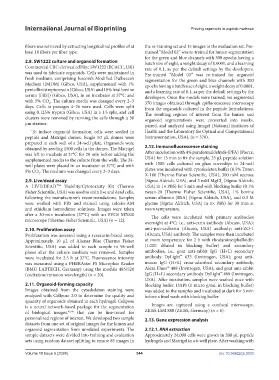Page 352 - IJB-10-5
P. 352
International Journal of Bioprinting Printing organoids in peptide matrices
fibers was retrieved by extracting longitudinal profiles of at the re-training set and 15 images in the evaluation set. Pre-
least 10 fibers per fiber type. trained “Model 02” was re-trained for lumen segmentation
for the green and blue channels with 300 epochs having a
2.8. SW1222 culture and organoid formation batch size of eight, a weight decay of 0.0001, and a learning
Commercial CRC-derived cell line SW1222 (ECACC, UK) rate of 0.1, as per the default settings by the developers.
was used to fabricate organoids. Cells were maintained in Pre-trained “Model 03” was re-trained for organoid
fresh medium, comprising Isocove’s Modified Dulbecco’s segmentation for the green and blue channels with 300
Medium (IMDM) (Gibco, USA), supplemented with 1% epochs having a batch size of eight, a weight decay of 0.0001,
penicillin/streptomycin (Gibco, USA\ and 10% fetal bovine and a learning rate of 0.1, as per the default settings by the
serum [FBS]) (Gibco, USA), in an incubator at 37°C and developers. Once the models were trained, we segmented
with 5% CO . The culture media was changed every 2–3 370 images obtained through epifluorescence microscopy
2
days. Cells in passages 4–26 were used. Cells were split from the organoids cultured in the peptide formulations.
using 0.125% trypsin (Gibco, USA) in a 1:5 split, and cell The resulting regions of interest from the lumen and
clusters were removed by running the cells through a 30 organoid segmentations were converted into masks,
µm strainer. paired, and analyzed using ImageJ (National Institutes of
To induce organoid formation, cells were seeded in Health and the Laboratory for Optical and Computational
peptide and Matrigel domes. Single 50 µL domes were Instrumentation, USA), (n = 370).
prepared in each well of a 24-well plate. Organoids were
obtained by seeding 1500 cells in the domes. The Matrigel 2.12. Immunofluorescence staining
was left to incubate at 37°C for 20 min before adding the After incubation with 4% paraformaldehyde (PFA) (Pierce,
supplemented media to the culture from the walls. The 24- USA) for 15 min to fix the sample, 25 μL peptide solution
well plates were placed in an incubator at 37°C and with with 1500 cells cultured on glass coverslips in 24-well
5% CO . The medium was changed every 2–3 days. plates was incubated with cytoskeleton buffer (0.5% Triton
2 X-100 [Thermo Fisher Scientific, USA], 300 mM sucrose
2.9. Live/dead assay [Sigma Aldrich, USA], and 3 mM MgCl [Sigma Aldrich,
2
A LIVE/DEAD Viability/Cytotoxicity Kit (Thermo USA] in 1× PBS) for 5 min and with blocking buffer (0.1%
TM
Fisher Scientific, USA) was used to stain live and dead cells, tween-20 [Thermo Fisher Scientific, USA], 1% bovine
following the manufacturer’s recommendations. Samples serum albumin [BSA] [Sigma Aldrich, USA], and 0.3 M
were washed with PBS and stained using calcein-AM glycine [Sigma Aldrich, USA] in 1× PBS) for 30 min at
and ethidium homodimer solutions. Images were taken room temperature.
after a 30-min incubation (37°C) with an EVOS M7000 The cells were incubated with primary antibodies
microscope (Thermo Fisher Scientific, USA) (n = 12).
overnight at 4°C; i.e., anti-ezrin antibody (Abcam, USA);
2.10. Proliferation assay anti-pan-cadherin (Abcam, USA) antibody; anti-ZO-1
Proliferation was assessed using a resazurin-based assay. (Abcam, USA) antibody. The samples were then incubated
Approximately, 10 µL of Alamar Blue (Thermo Fisher at room temperature for 2 h with rhodamine/phalloidin
Scientific, USA) was added to each sample in 96-well (1:200 diluted in blocking buffer) and secondary
plates after the culture medium was removed. Samples antibodies, i.e., goat anti-rabbit IgG (H+L) secondary
were incubated for 2.5 h at 37°C. Fluorescence intensity antibody DyLight™ 633 (Invitrogen, USA); goat anti-
was measured using a PHERAstar FS Microplate Reader mouse IgG (H+L) cross-adsorbed secondary antibody,
(BMG LABTECH, Germany) using the module 485/520 Alexa Fluor™ 488 (Invitrogen, USA); and goat anti-rabbit
(excitation/emission wavelength) (n = 20). IgG (H+L) secondary antibody DyLight™ 488 (Invitrogen,
USA). After incubation, samples were washed once with
2.11. Organoid-forming capacity blocking buffer. DAPI (1 micro g/mL in blocking buffer)
Images obtained from the cytoskeleton staining were was added to the samples and incubated at dark for 5 min
analyzed with Cellpose 2.0 to determine the quality and before a final wash with blocking buffer.
quantity of organoids obtained in each hydrogel. Cellpose
is a neural network-based package for the segmentation Images are captured using a confocal microscope,
of biological images. 45,46 that can be fine-tuned for ZEISS LSM 880 (ZEISS, Germany) (n = 6).
personalized regions of interest. We developed two sample 2.13. Gene expression analysis
datasets from one set of original images for the lumen and
organoid segmentation from unrelated experiments. The 2.13.1. RNA extraction
sample datasets were divided into training and evaluation Approximately 24,000 cells were grown in 200 µL peptide
sets using random dataset splitting to ensure 85 images in hydrogels and Matrigel in a 6-well plate. After washing with
Volume 10 Issue 5 (2024) 344 doi: 10.36922/ijb.3033

